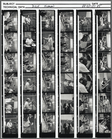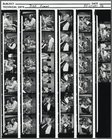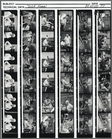This collection is also available in Archives & Manuscripts
View In Archives »
Collection Data
- Description
- George Mesrop Avakian (born 1919) is an American music producer, artist manager, writer, and educator best known for his work with artists such as Louis Armstrong, Miles Davis, Duke Ellington, John Cage, Alan Hovhaness, Keith Jarrett, Sonny Rollins, his wife Anahid Ajemian, and many other musicians and composers. Violinist Anahid Ajemian (born 1924) specialized in performing new music as a soloist; with her sister, the pianist Maro Ajemian (1921-1978); and with the Composers String Quartet. The George Avakian and Anahid Ajemian papers (1908-2012) document the careers and lives of the producer and violinist through personal and professional correspondence; published and unpublished writings and speeches; contracts and other business papers; scores; clippings; photographs; awards; posters; and visual art. The bulk of the collection consists of correspondence, writings, and photographs illustrating George Avakian's career as a recording producer and artist manager.
- Names
- Avakian, George (Creator)
- Ajemian, Anahid (Associated name)
- Ajemian, Maro (Associated name)
- Dates / Origin
- Date Created: 1908 - 2013
- Library locations
- Music Division
- Shelf locator: JPB 14-28
- Topics
- Armstrong, Louis, 1901-1971
- Cage, John
- Davis, Miles
- Ellington, Duke, 1899-1974
- Goodman, Benny, 1909-1986
- Hovhaness, Alan, 1911–2000
- Jarrett, Keith
- Lloyd, Charles, 1938-
- Shankar, Ravi, 1920-2012
- Columbia Records, Inc
- Pacific Jazz Records
- RCA Records
- Warner Bros. Records
- Hiroshima-shi (Japan)
- New York (N.Y.)
- Philippines
- Jazz
- Newport Jazz Festival
- Sound recording industry
- Third stream (Music)
- World War, 1939-1945 -- Pacific Area
- Musicians
- Producers (managers)
- Genres
- Art
- Awards
- business records
- Clippings
- Contracts
- Correspondence
- Photographs
- Posters
- Scores
- speeches (documents)
- writings (documents)
- Notes
- Biographical/historical: George Mesrop Avakian (born 1919) is an American music producer, artist manager, writer, and educator best known for his work with artists such as Louis Armstrong, Miles Davis, Duke Ellington, John Cage, Alan Hovhaness, Keith Jarrett, Sonny Rollins, his wife Anahid Ajemian, and many other musicians and composers.
Avakian was born in Armavir, Armenia, the oldest of three children of Mesrop Avakian. His brother was the film director, editor, and photographer Aram Avakian (1926-1987). The Bolshevik revolution forced his family to immigrate to the United States in 1923, and they settled in New York City.
Avakian attended the Horace Mann School for Boys in Riverdale, the Bronx, and entered Yale University in 1937 to pursue an English degree. In New Haven, he joined a local group of jazz enthusiasts centered around Marshall Stearns, a jazz writer and collector who later founded the Institute of Jazz Studies. Avakian soon became an expert on recorded jazz in an era when very little information about the music was published.
Aware that much of the recorded jazz of the 1920s and early 1930s was no longer available for purchase and study, Avakian envisioned a new way of recording and releasing the music on record using the same "album" format used for classical recordings in the 78-rpm era: multi-disk sets with extensive, well-researched annotations to supply the listener with information about the musicians and the music's historical context. After writing letters to several record companies outlining the idea, he was invited by Decca Records in 1939 to produce Chicago Jazz, a set of new recordings by Chicago musicians led by Eddie Condon.
Inspired by the Decca release, John Hammond suggested to the American Record Company that they hire Avakian in 1940, while he was still a student. (The company renamed itself Columbia Records around the same time.) He was assigned to search the company's warehouse for deleted and never-released masters and create reissue packages for them, resulting in the Columbia Hot Jazz Classics series.
In 1941, Avakian was drafted into the U.S. Army. After being stationed at Fort Benning, Georgia and receiving specialized training at Harvard University, Avakian served in the Pacific from 1944 to 1946. During his tour of duty he traveled to New Guinea, took part in the landings in Leyte and Mindanao in the Philippines, and served in the occupation forces in Japan. During his time there, he visited the city of Hiroshima several days after the first atomic bomb was dropped; he wrote an essay, never published, about the experience.
Avakian continued his jazz writing and producing career during his military service. While stationed in Boston he produced a radio broadcast for the Office of War Information, and in the Pacific he wrote articles on jazz published by Down Beat, Jazz magazine, Hot Jazz Booklets, and Mademoiselle. After the war, Avakian continued to write for magazines, and he expanded into teaching in 1948 when he taught one of the first academic jazz history courses at New York University. That same year, Avakian collaborated with Walter Schaap on an English translation and expansion of Charles Delaunay's Hot Discography, the first significant catalog of existing jazz records.
Following his discharge in 1946, Avakian immediately returned to Columbia, where he resumed production of the Hot Jazz Classics series, as well as the Special Editions and Archives series. Within a few years his mandate and opportunities became almost unlimited. In 1948, he was appointed head of the International department, overseeing the production of new foreign recordings, as well as the domestic issue of recordings by foreign subsidiaries. It was through this job that he met and produced Edith Piaf and Charles Aznavour.
In 1948, Avakian played a key role in pushing Columbia to develop and adopt the new technology of the 33 1/3-rpm long-playing record. He issued the first 100 popular albums in the format, making Columbia the leader in firmly establishing the microgroove record as a primary vehicle for music retailing for the next four decades.
In 1952, he was appointed the first director of the newly-formed Popular LP department, in addition to his International department duties. This department produced jazz artists as well as popular singers and Broadway cast recordings. Among the many artists Avakian signed and produced at Columbia during the 1950s were Dave Brubeck, Louis Armstrong, Miles Davis, Ravi Shankar, Johnny Mathis, Rita Reys, Erroll Garner, and Buck Clayton.
Avakian was innovative in other ways as well: he made Columbia the first major company to record live jazz and popular music, releasing Benny Goodman's 1938 concert at Carnegie Hall, and recording Lionel Hampton, Harry James, and Louis Armstrong live. From 1956 until 1963, Avakian produced several cornerstone albums recorded live at the Newport Jazz Festival, including Ellington At Newport (1956) and the companion album to the film Jazz On A Summer's Day (1958). He was also one of the first producers of popular music to fully embrace multitrack recording and tape editing techniques, overdubbing Louis Armstrong in 1955 and overdubbing and editing the Miles Davis album Miles Ahead in 1957.
Avakian was one of the co-founders of the National Association of Recording Arts and Sciences (NARAS) in 1957. He later served as president of the association from 1966 to 1967.
In March 1958, Avakian left Columbia and became vice president in charge of New York operations for World Pacific Records. He remained only a few months before departing to cofound Warner Brothers Records. While there, Avakian discovered the comedian Bob Newhart, signing him and producing his Grammy-winning album, The Button Down Mind of Bob Newhart. He also signed and produced the Everly Brothers and Bill Haley and the Comets for the label.
Avakian moved to RCA Records in 1960, where he produced Sonny Rollins, Benny Goodman, Paul Desmond, and Gary Burton, among others. He accompanied Goodman on his tour of the Soviet Union in 1962, the first tour of the country by an American jazz band, and produced the first jazz album ever recorded there, a live concert. Avakian left RCA around 1964.
In the early 1960s, Avakian began to independently produce and manage artists, including the Orchestra U.S.A. ensemble, the singer/songwriter Bob Morrison, and the saxophonist Charles Lloyd, arranging a deal for him with Atlantic Records, and booking and managing domestic and foreign tours for him from 1965 to 1969. Avakian also arranged for the Lloyd quartet to make the first tour by a small American jazz group in the Soviet Union in 1967, and recorded the group there as well. It was through Lloyd that Avakian met the group's pianist, Keith Jarrett. He began managing Jarrett, launching his performance and recording career on the Columbia, Atlantic, Impulse, and ECM labels.
In addition to his production of many Broadway cast recordings, Avakian notably involved himself in two theater projects. In 1947, he arranged for a group of musicians under the leadership of the saxophonist Eddie Barefield to perform incidental music for the play A Streetcar Named Desire during its Philadelphia and Broadway runs. In 1965, he was an associate producer of the first Off-Broadway revival of Marc Blitzstein's The Cradle Will Rock, and personally financed the recording of the cast album.
Avakian worked hard to foster intercultural exchange between the United States and the Soviet Union. In addition to the landmark Benny Goodman and Charles Lloyd tours, he was the first to record Soviet and American artists together (Pavel Lisitsian of the Bolshoi Opera and pianist Maro Ajemian, for New York Records in 1957). In 1960, he attempted to arrange a performance in Moscow by Maro Ajemian of Aram Khatchaturian's music, conducted by the composer. In 1971 and 1972, he assisted the Duke Ellington and the Thad Jones/Mel Lewis orchestras in planning their Soviet visits, and he befriended many Russian musicians, composers, and writers, such as Leonid Pereverzev, Oleg Lundstrem, and Valery Ponomarev. Avakian also sponsored the first performance by Soviet musicians in the United States (at the Village Gate in 1988), and arranged for the Branford Marsalis Quartet to play at the Moscow International Jazz Festival, the debut of American performers at that event, in 1990. For his life-long efforts, the Soviet Composers Union successfully pushed for him to receive the Order of Lenin, the former Soviet Union's highest honor, in 1990.
Avakian's other honors include the Knight of Malta (1984); the Down Beat Lifetime Achievement Award (2000); the prestigious French jazz award, the Django d'Or (2006); the French rank of Commandeur des Arts et Lettres (2008); the Trustees Award from the National Association of Recording Arts and Sciences for contributions to the music industry worldwide (2009); and the National Endowment for the Arts Jazz Master award (2010).
In his retirement, Avakian continued to involve himself in independent recording productions for various artists, and, in the 1980s, managed two vocalists: Helen Merrill and Datevik Hovenasian. In the 1990s and 2000s, Sony Legacy consulted him for the reissues of several Miles Davis and Louis Armstrong albums. He also remained active in jazz research and writing, and discovered several previously-unknown Louis Armstrong compositions at the Library of Congress. In 1997, he produced performances and a recording of them by trumpeter Randy Sandke and other musicians.
Avakian met his wife, the violinist Anahid Ajemian (born 1924), in 1946 and the couple married in 1948. Ajemian's parents, like the Avakians, were Armenian expatriates who had moved to New York City in 1922. Ajemian's sister, Maro (1921-1978), was a pianist. Both sisters studied at the Institute of Musical Art (later the Juilliard School), launched their careers at Town Hall (in 1940 and 1946), and became interested in contemporary composers. Maro Ajemian performed the U.S. premiere of Aram Khatchaturian's piano concerto while she was still a student at Juilliard. In the early 1940s, she met the composer Alan Hovhaness, who was unknown at that time, and started performing his music. Through Hovhaness, the Ajemians met John Cage, Henry Cowell, Ernst Krenek, Lou Harrison, Wallingford Reigger, Carlos Surinach, and Ben Weber, several of whom wrote works for the duo. The Ajemians produced the first recordings of some of these compositions as well.
George Avakian personally financed and produced the first three albums by Hovhaness and Cage (unrelated to his jobs at Columbia) and, in 1958, presented The 25-Year Retrospective Concert of the Music of John Cage at Town Hall, an event he also recorded and sold independently. The year before, Avakian and Ajemian produced a three-concert series at Town Hall titled Music For Moderns, featuring jazz musicians and modern composers on the same bill, a very unusual venture for its time. The concerts featured Anahid Ajemian, Dimitri Mitropoulos, the Duke Ellington Orchestra, the Modern Jazz Quartet, Mahalia Jackson, Chico Hamilton, the composers Virgil Thomson and Carlos Surinach, pianist William Masselos, violist Walter Trampler, and opera baritone Martial Singher, among others.
In the mid-1960s, at the request of Gunther Schuller, Ajemian and violinist Matthew Raimondi formed the Composers String Quartet, with the goal of featuring new music by American composers. The group rapidly became renowned and, sponsored by the U.S. State Department, toured the world in the late 1960s and 1970s, including countries such as China, India, and Sierra Leone, where no string quartet had ever performed before. It was the first group to record and regularly perform the string quartets of Elliott Carter. In 1975, it became Quartet-in-Residence at Columbia University. Avakian managed the quartet for several years in the late 1970s. It disbanded in 1999, and Anahid Ajemian continued to perform and teach at Columbia and the Juilliard School into the early 2000s.
- Content: The George Avakian and Anahid Ajemian papers (1908-2013) document the careers and lives of the producer and violinist through personal and professional correspondence; published and unpublished writings and speeches; contracts and other business papers; scores; clippings; photographs; awards; posters; and visual art. The bulk of the collection consists of correspondence, writings, and photographs illustrating George Avakian's career as a recording producer and artist manager. The collection is arranged in three series: George Avakian Papers, Anahid and Maro Ajemian Papers, and Photographs.
The George Avakian papers date from 1924 to 2013. They detail his work producing, managing, or assisting a wide variety of musicians and recording artists; how he helped develop those artists' careers and art; the history of Avakian's careers at Columbia, World Pacific, Warner Brothers, and RCA Records; and his later projects as an independent manager and producer. Broadly, the papers show the development of the recording industry over the course of his career. They reveal the intertwined histories through personal and professional correspondence with recording artists or their management; correspondence with other record industry figures; published and unpublished articles, liner notes, essays, and historical accounts by Avakian; clippings; record company memos; business, recording, and production notes; touring information; contracts; publicity material; awards; posters; visual art; and photographs. Many of Avakian's writings were created with the intention of compiling a memoir of his career.
The Ajemian papers, dating from 1927 to 2011, document the lives and careers of George Avakian's wife, the violinist Anahid Ajemian, and her sister, the pianist Maro Ajemian. They contain biographical papers on both musicians; files on individual performances by the Ajemians as a duo and as solo artists; annotated scores; clippings; contracts; publicity material; letters from the composers Lou Harrison, Edgard Varèse, John Cage, and Alan Hovhaness; and obituaries and memorial tributes for Maro Ajemian. The scores include pieces for violin as well as compositions performed by the Composers String Quartet. Composers represented include Alan Hovhaness, Mel Powell, Wallingford Riegger, and Ben Weber.
The collection holds photographs dating from 1908 to 2012. They include images of Avakian or Ajemian with various musicians and colleagues, as well as candid, publicity, or performance photographs of those musicians, some never published. These include such figures as Louis Armstrong, Maro Ajemian, Dave Brubeck, the Composers String Quartet, Henry Cowell, Miles Davis, Eric Dolphy, Duke Ellington, Gil Evans, Benny Goodman, Alan Hovhaness, Keith Jarrett, Charles Lloyd, Johnny Mathis, Sonny Rollins, and Ravi Shankar. Also present are portraits of Avakian, some by Carl Van Vechten and William Gottlieb, and photographs of the Avakian and Ajemian families. Photographs of the 2004 Satchmo Summerfest appear only in digital form. Electronic records are currently unavailable.
- Physical Description
- Extent: 46.83 linear feet 118 boxes, 6 oversized folders 113.82 Megabytes (33 computer files)
- Type of Resource
- Text
- Still image
- Identifiers
- NYPL catalog ID (B-number): b20513910
- MSS Unit ID: 22589
- Universal Unique Identifier (UUID): 8e52d7f0-5ee4-0133-0a0b-00505686d14e


